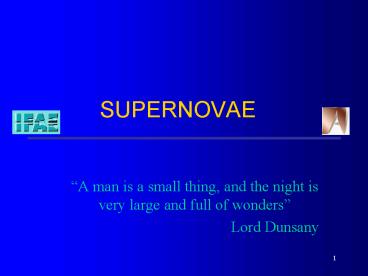SUPERNOVAE - PowerPoint PPT Presentation
1 / 17
Title:
SUPERNOVAE
Description:
'A man is a small thing, and the night is very large and full of wonders' Lord Dunsany ... About one per century in our galaxy. Last recorded seen by naked-eye : ... – PowerPoint PPT presentation
Number of Views:54
Avg rating:3.0/5.0
Title: SUPERNOVAE
1
SUPERNOVAE
- A man is a small thing, and the night is very
large and full of wonders - Lord
Dunsany
2
CONTENTS
- Introduction
- Classification of SNe
- Core-Collapse Mechanism
- Thermonuclear Mechanism
3
1. Introduction
- Supernovae are one of the most energetic
explosive events in Nature. - RARE. About one per century in our galaxy
- Last recorded seen by naked-eye 1006 (Lupus),
1054 (Chinese), 1572 (Brahe), 1604(Kepler) - SN1054 was as luminous as the moon for same
days - LUMINOUS. 600 millions 4 billions L?
- A SN in 10 sec releases 100 times the energy
that the sun realises in all its life - BRIEF. Luminosity falls by a factor of 100 during
the course of 4 months
4
INTRODUCTION
SN 1987 seen by naked-eye(23 February 1987, Large
Magellanic Cloud)
- The best studied SN of
- all times
- Study of SN dynamics
- Study of neutrino
- masses
For the first time, it was possible to look back
in photographic archives at the location of the
explosion and find the progenitor star of the
Supernova
5
INTRODUCTION
In Kamiokande II, the detection method consisted
of
?e e? ?e e
Nobel Prize 2002 Koshiba
6
Classification of SNe
7
Classification of SNe
Basic SN types spectra
CappelaroTuratto, Astro-ph,0012455
8
Classification of SNe
9
Classification of SNe
CappelaroTuratto, Astro-ph,0012455
Light Curves
- Type Ia SN
- Similar luminosity
- Similar spectral evolution
- Distance indicators
- (cosmological parameters)
- Type II SN
- Dramatic differences
- II-P (plateau)/ II-L (rapid declination)
10
Classification of SNe
11
3. Core - Collapse Mechanism
- The Final Catastrophe Of a Massive Star (8M? lt
M lt 60M?)
- Life Cycle of a Massive Star
- Hydrostatic equilibrium
- gravitys pull goes inward
- Thermal pressure goes outward
- Thermal equilibrium
- heat and energy flow out from the core to be
emitted as light - Fusion hydrogen, helium, carbon, neon, oxygen,
silicon - At the end of Silicon burming there is no more an
energy source. - Any fusion or fission reactions in which iron
participates absorb rather than release energy
- At the end...
- Layered Structure
- Dense Iron Core
- Progenitor Star (type II) with degenerate iron
core - ? 107 gcm-3
- T ? 1010 K
- MCore ? 1.4M?
- RCore ? 4000km
12
Core-Collapse Mechanism
Stage 1- Core Collapse
Once the star has finished its fuel the core
cools because of two reasons
- Iron dissociation ? fusion of light nuclei ? the
star continues emitting energy - Degenerate e- gas ? p e-(2.25 MeV)? n ?e
(neutronization) ? ?e escapes and remove energy
b) ?Contraction turns into a free-fall collapse,
vast amount of neutrinos are produced In less
than a second the inner core radius goes from
4000 km to 10 km (matter from the rest of the
core is falling inward)
13
Core-Collapse Mechanis
Stage 2- Core Bounce
Once the ? gt 31014 gcm-3, the very centre of
the core (10 km) becomes incompressible and its
collapse abruptly halts because of NUCLEON
degeneration
- The inner core violently rebounces (as a
overcompressed rubber ball that suddemly is
allowed to return to equilibrium), a layer of
dense matter surges at 10.000 km/s (shock wave) - Matter from the outer layers is falling
inward at 60.000 km/s - Shock wave loses energy and stops its rapid
outward movement as it founds the infalling
matter - The region between the shock wave and the inner
core is called the quasi-static layer .
14
Core-Collapse Mechanism
Making Stars Explode
Because the neutrinos free path is smaller than
the radius of the quasi-static layer, the
falling matter becames very hot, expands and
surges outwards. Finally, ths star erupts in an
explosion that ejects the stars outer layers
into space. This nebulae will form the planets,
other stars... All that remains of the star is
a very dense object called neutron star or a
black hole
PROBLEM Turning the implosion into an
explosion!!! There are several models explaining
the explosion, but until now due to the enormous
number of parameters involved and the great power
of computing needed, simulations do not succeed
in obtaining an explosion
15
4. Thermonuclear Mechanism
- The Mortal Game in the Danse
of a Stellar Couple
This mechanism concerns type Ia SNe It consists
of a Binary System (white dwarf companion) in
which the WD accrettes matter for the companion
star White dwarfs are formed from intermediate
mass stars (M lt 8M? ) and are composed of C and O
with a strongly degenerate electrons
By the pull of gravity, every object attracts
every object in the Universe
16
Thermonuclear Mechanis
Equipotencial contours in the equatorial plane
of a binary system rotating about its center of
mass(? X) One unique surface intersects itself
at the point L1, called the inner Lagrange
point This surface defines two regions called
Roche Lobes Mass accretion can occur if one of
the stars fills its Roche Lobes.
17
Thermonuclear Mechanism
For masses above 1.44M?, there cannot be balance
between electron degeneracy and the gravitational
force. The collapse continues until is stopped by
neutron degeneracy
Animation of accrettion in an X-ray binary system
(normal star
collapsed star)
- In the thermonuclear mechanism
- The red giant fills its Roche Lobe,
- The white dwarf accretes matter for the
secondary star until reaches the Chandrasekhar
limit
- The sudden collapse of the star can cause runaway
fusion of its - C ,O and the star becomes a huge nuclear bomb.

